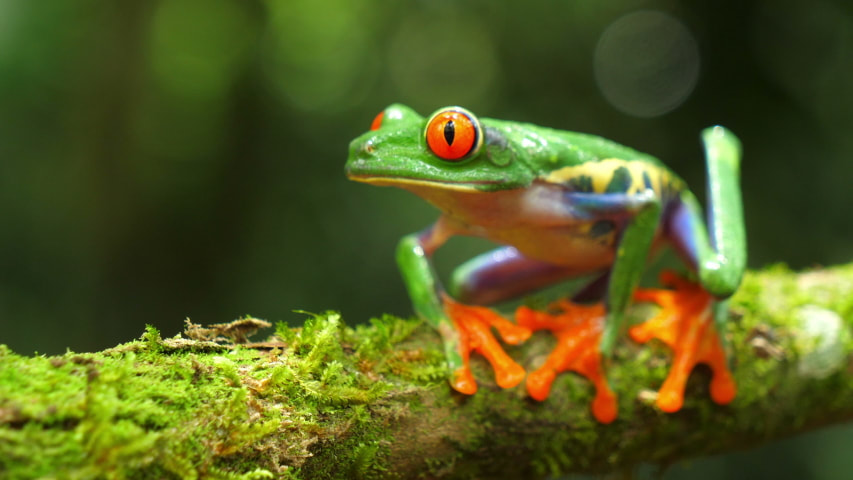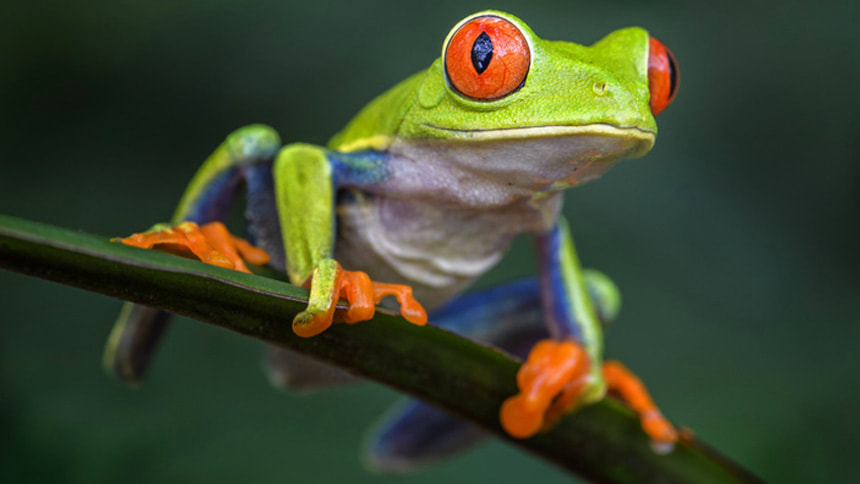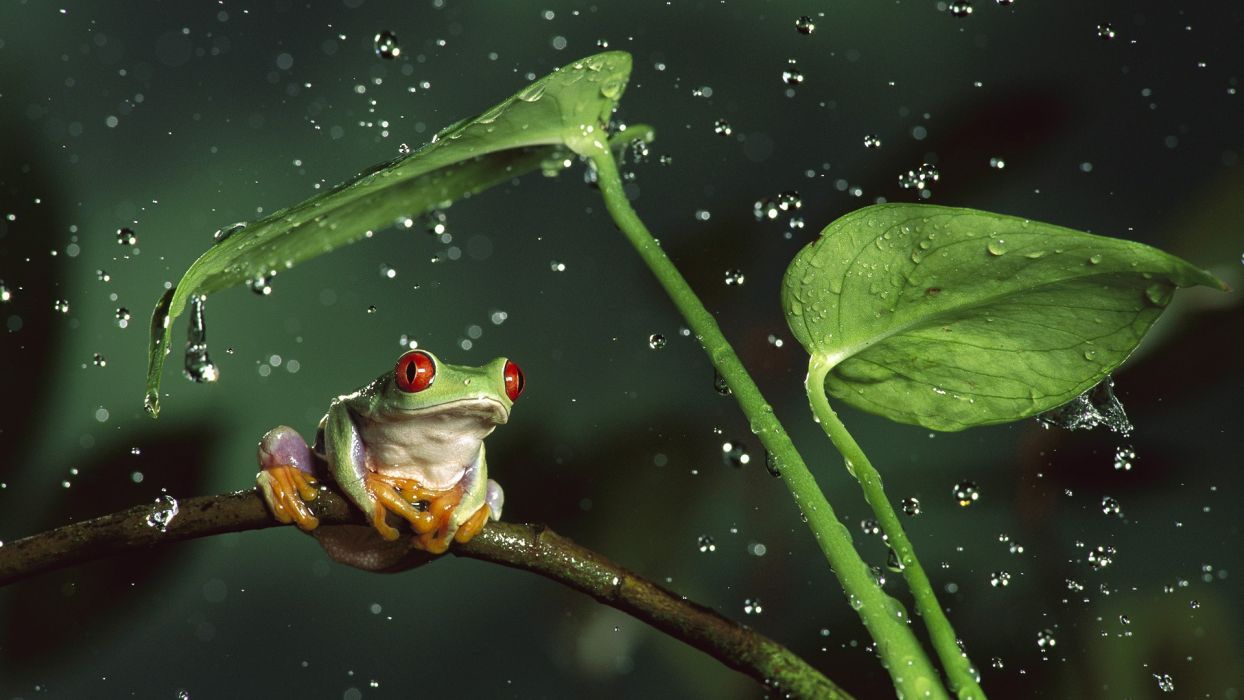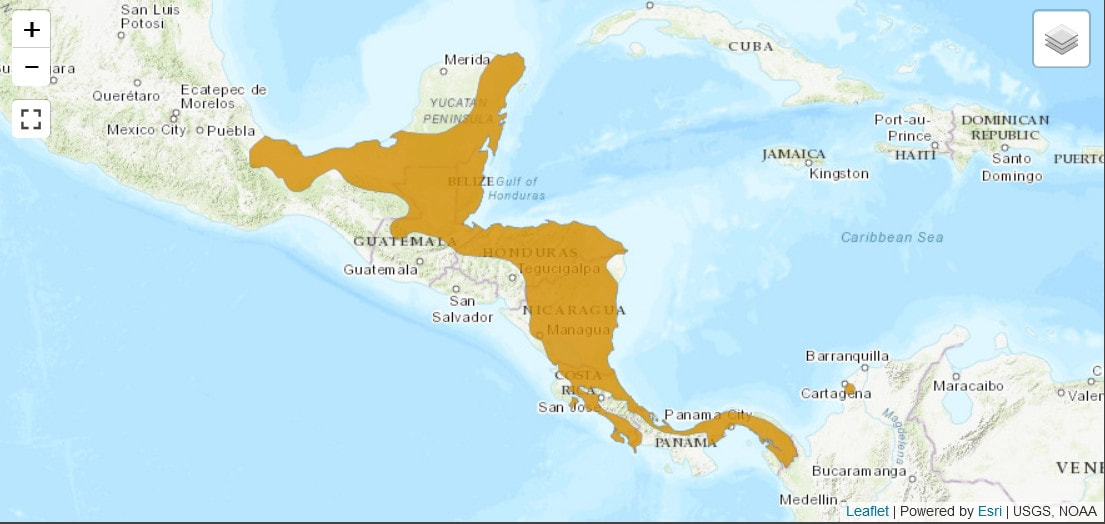|
Red-eyed tree frogs, despite their conspicuous coloration, are not venomous. They are found in tropical lowlands from southern Mexico, throughout Central America, and in northern South America. Nocturnal carnivores, they hide in the rain forest canopy and ambush crickets, flies, and moths with their long, sticky tongues. Red-eyed tree frogs are not endangered. But their habitat is shrinking at an alarming rate, and their highly recognizable image is often used to promote the cause of saving the world's rain forests. The Red-eyed tree frog is a slender, delicate frog with webbed hands and feet and is one of the most common tree frogs kept in captivity as pets, perhaps because of their vivid colors and overall beauty. They are medium sized frogs, with females reaching around 3.5 inches in length, and males around 3 inches. They begin their lives under water and later spend their adult life on land. They inhabit low and tropical forests in Veracruz and Oaxaca, Mexico, into Central America, Panama and Costa Rica, and farther south into Columbia, South America. Their environment is rather warm year-round with high levels of humidity. Like most amphibians, they are dependent on water for most of their life. In the forests of Belize, the Red-eyed tree frog minimizes water loss by resting underneath leaves and tucking its limbs up close to its body. They are quite a common site for locals and tourists in some regions and often invade public areas close to the forests. Red Eyed Tree Frogs “Poster Child” for Rainforest Conservation Pictures of the Red-eyed tree frog are seen all over the world and they have become a “poster child” for the Save the Rainforest campaign. Their bright coloration and their status as an indicator species makes them the perfect candidate to bring attention to this important cause. THEY SLEEP BY DAY - ON THE UNDERSIDE OF GREEN LEAVES During the day light hours, these frogs spend their time sleeping on the undersides of green leaves, for which they blend into nicely. While resting, the brightly colored sides are covered by the rear limbs, and the eyes are covered with a mesh-like membrane, so that the frogs are almost entirely camouflaged green. When disturbed, they flash their bulging red eyes and reveal their huge, webbed orange feet and bright blue-and-yellow flanks. This technique is called startle coloration, ad may give a bird or a snake pause, offering a precious instant for the frog to spring to safety. This may work well in most cases, however, predators are not always fooled. While awake they are at higher risk of predication than when sleeping camouflaged against green leaves. Their neon-green bodies may play a similar role in thwarting predators. Many of the animals that eat red-eyed tree frogs are nocturnal hunters that use keen eyesight to find prey. THEIR MOST NOTABLE FEATURE - IS THEIR RED BULGING EYES Juvenile morphs are brownish green, and change to bright green as they mature. In the wild, and in captivity, these nocturnal frogs typically spend their days attached to green leaves, sometimes in small groups. They position themselves in such a way so as to disguise every colorful part of their body in an attempt to blend into the leaves. They do this so well that they are often difficult to find. Their habitat is crawling with potential predators, including bats, snakes, birds, small mammals, insects and lizards. This frog is not toxic, and so they rely heavily on camouflage and discretion to avoid predication. THEIR BRIGHT COLORS ARE A NATURAL DEFENSE AGAINST PREDATORS The bright colors found on the sides of these frogs are often referred to as “flash colors,” as they are flashed to potential predators. The shocking colors of this frog may over-stimulate a predator's eyes, creating a confusing ghost image that remains behind as the frog jumps away. This may throw off those predators that rely mainly on visual prey detection, such as snakes, and birds. This is similar to the effects of gazing at a bright light or object for a period of time, resulting in the image being “burned” into the eyes when you look away. Still, despite their unique defense methods, they are preyed upon regularly. RED EYED TREE FROGS LIVE IN THE BELIZEAN RAINFORESTS Habitat - Although these beautiful creatures are not considered threatened, the condition of their habitat is of great concern. Problems such as global warming, wetland drainage, atmospheric and climatic changes, pollution and deforestation have all taken a severe toll on the rainforest. With less rainforest comes fewer tree frogs. Amphibian populations are known to suffer environmental effects sooner than other populations. Red-eyed tree frogs inhabit areas near rivers and ponds in rainforests and humid lowlands on the Atlantic slopes from southern Veracruz and northern Oaxaca in Mexico, to central Panama and northern Colombia. They also live on the Pacific slope in southwestern Nicaragua and southwestern Costa Rica to eastern Panama. The optimum temperature for red-eyed tree frogs is 75–85 °F (24–29 °C) in the daytime, and 66–77 °F (19–25 °C) at night. Behavior - Red Eyed Tree Frogs spend a majority of their lives in trees, and are excellent jumpers. Red-eyed tree frogs are not poisonous and rely on camouflage to protect themselves. During the day, they remain motionless, cover their blue sides with their back legs, tuck their bright feet under their bellies, and shut their red eyes. Thus, they appear almost completely green, and well hidden among the foliage. The large red eyes serve as a defensive adaptation through deimatic behavior. When a red-eyed tree frog detects an approaching predator, it abruptly opens its eyes and stares at the predator. The sudden appearance of the red eyes may startle the predator, giving the frog a chance to flee. Diet - The Red-eyed tree frog, a strict carnivore, is also an avid and skilled hunter. It eats mostly insects, crickets, moths, grasshoppers, flies and beetles, catching them with its long, sticky tongue. It also eats other small invertebrates and sometimes will even other eat small frogs. Most individuals are strictly nocturnal, and will only feed at night. Did You Know?
THE BREEDING SEASON IS BETWEEN OCTOBER & MARCH EACH YEAR Mating Red-eyed tree frogs spend their lives near water because they must return to the water to lay their eggs. Like many tropical frogs, red-eyed tree frogs enter breeding mode during the rainy season. At this time, the males will croak incessantly to attract females, and will wrestle other males in the near vicinity. In addition to croaking, males are known to “quiver” during the breeding season. This occurs at the peak of a croak, while facing another male. During this staring contest, any sign of movement from one frog prompts a wrestling match between the males. During the mating season, the male frogs shake the branches where they are sitting to improve their chances of finding a mate by keeping rivals at bay. This is the first evidence that tree-dwelling vertebrates use vibration to communicate.When rainfall is at its highest, a male red-eyed treefrog calls "chack" to get the attention of the female. Reproduction Breeding occurs from October to March, usually near ponds of water. While locked in an embrace, the male fertilizes 30 to 50 pale eggs as the female lays them on a leave over standing water. In five days the eggs hatch into tiny brown tadpoles and they wiggle their way down the leaf to the water below. The tadpoles breathe with gills and swim with a tail. It takes the tadpoles 75 to 80 days to metamorphose into a frog. As they mature, they lose their tail, they develop lungs (for breathing air), and they become brightly colored. The adult frog will spend most of the rest of its life in the forest canopy, often hidden among bromeliads. The female will carry the male on her back for several hours during the mating process. The female chooses a leaf above a pond or large puddle on which to lay her clutch of roughly 40 eggs. She will produce a sticky jelly to glue the eggs together; this protects the eggs from splitting and dehydration. The eggs develop into tadpoles, which hatch after six to seven days and fall into the water below. Red-eyed treefrog eggs hatch early when a change in the environment signals a danger to their survival. Dragonflies, fish, and water beetles prey on the tadpoles. The tadpoles remain in the water from three weeks to several months, until they metamorphose into frogs. The time of metamorphosis depends on duration of larval stage, which varies depending on environment. After metamorphosis, the color of tadpoles' torsos changes from brown to green, and their eyes, which are initially yellow, turn into deep red without much side patterning. These changes mark maturity. Young frogs that survive the first few weeks after metamorphosis move into the undergrowth and security of plants near their natal pools, often into the hollows of tubular plants such as bromeliads. Young frogs prey on very small flies and other insects during the first months of their lives. The young mature after two years and begin mating at the age of three to four years. These treefrogs are known to live up to five years, depending on the health and conditions of their habitat. 11 Amazing Facts About Red Eyed Tree Frogs Agalychnis callidryas, better known as the red-eyed tree frog, is one charming amphibian. With bright red eyes, colorful sides, and an extremely expressive face, it’s hard not to be captivated by this wonderful frog. 1. Red Eyed Tree Frogs have been around for thousands of years. Frogs, in general, are a pretty old bunch. Fossils show that frogs have been around for thousands of years. 2. Red Eyed Tree Frogs are masters of disguise. These amphibians are arboreal, meaning they spend a lot of time hiding in the trees. The frogs live in tropical lowlands in Central America and northern South America, and though one might think that its bright red eyes and blue and yellow markings would put the amphibian in danger, the crafty frog actually uses its flashy colors to its advantage. When seated on a leaf, the red-eyed tree frog tucks its legs in close to its body and closes its eyes to hide—but when they sense a predator, they open their eyes and jump away, exposing a whole slew of dazzling colors. Some scientists believe that this sudden burst of color can startle animals and throw them off guard, but a more popular theory is that it helps the animal get back into hiding. 3. Red Eye Tree Frogs can best be seen at night. During the day, the red-eyed tree frog hides its colors and sleeps stuck under leaves, where it blends into the foliage perfectly—sometimes, the frog will even have tiny yellow spots that resemble leaf blemishes. At night, when they're less at risk of becoming a meal, the frogs are much more active; they spend the time hunting for insects. 4. Red Eyed Tree Frogs are not venemous. Tree frogs rely more heavily on their camouflage for protection, but they do have some toxins in their skin. These toxins are not dangerous, but they do leave a bad taste in a predators’ mouth. 5. Red Eyed Tree Frogs use their eyes to swallow food. If you've ever seen a frog eat something, you might have noticed they close their eyes. Like most frogs, red-eyed tree frogs use their eyes to help swallow. Their tiny teeth hold the insect in place, and they retract their eyes into their body to push the meal down their throats. While they can swallow without the extra push from the eyes, it helps expedite the process so they can get moving. 6. Male Red Eyed Tree Frogs use vibrations to ward off competition. When marking territory, males will shake their perch violently. The vibrations tell other males that the area has already been reserved. Scientists used a miniature seismograph to verify that the shaking branches were due to the frogs’ movements and not the wind. The vibrations travel about 1.5 meters, giving the male frogs a good amount of personal space. 7. Red Eyed Tree Frogs mating season is from October to March. Mating season generally lasts from fall to early spring. Males climb down from their trees and gather around bodies of water; once each finds the perfect location, he'll start calling, at which point the females will descend from the trees and respond to the calls. 8. Male Red Eye Tree Frogs attach themselves to the back of a female. Once the female has selected her mate (it’s unclear what the deciding factors are, but it’s likely a mixture of size and call), the pair will go into amplexis: the female will carry the male around on her back for the course of the egg laying process. After the male hops on, the female draws in water that she uses to lay her gel-like eggs. After she lays her eggs on the bottom of a leaf, the male fertilizes them externally. 9. Red Eyed Tree Frog tadpoles can hatch early. Red-eyed tree frog eggs are laid under leaves that loom over water, so that when the eggs hatch, the tadpoles can fall directly in. These frogs-to-be generally hatch about a week after being laid, but they can emerge sooner, after just four or five days, if their survival depends on it. Because some species of snakes and wasps like to dine on the jelly-like eggs, the tadpoles are equipped with a special defense plan: If they detect movement or vibrations, they hatch prematurely and make their escape. 10. Red Eyed Tree Frogs takes a while to grow up. It takes a red-eyed tree frog one to two years to reach maturity, depending on how much they eat. The frogs are usually about 1.5 to 2 inches long, and females are always larger than the males (a necessity for giving piggyback rides). The frogs usually survive about 5 years in the wild, but can live much longer in captivity. 11. Red Eyed Tree Frogs can easily scale wet leaves. These amphibians can defy gravity and cling to leaves, sticks, and even glass. Frogs’ feet are not entirely flat: If you look at them under a microscope, you would see hexagonal nanopillars, which allow them to stick out and fit into irregular surfaces. These frogs can stick to almost any surface—especially anything moist. This Map Showing Present Areas Where "Red-Eyed" Tree Frogs can be Found
0 Comments
|
Is located on the island of Ambergris Caye, directly across from the Belize Barrier Reef, off the mainland coast of Belize. The property is nestled in a cluster of Australian Pine trees, backed to a littoral jungle, and surrounded by tropical gardens. It's about a one minute walk from the property to the beach, and a 10-15 minute drive from the island airstrip to the property.
We offer one bedroom suites (455 s.f.) of living area to include: livingroom, kitchenette, private bathroom and bedroom. We are also about a one minute walk from one of the best restaurants on the island serving (breakfast, lunch & dinner). Within walking distance you can find: (3) blocks is Robyn's BBQ (4) blocks is 2 fruit stands (5) blocks local grocery store IF YOU'RE COMING TO BELIZE TO............... If you're coming to Belize to dive the Blue Hole, descend the shelf walls at Turneffe, snorkel the Barrier Reef, explore Mayan ruins, rappel into a cave, kayak along the river through caves, zip line through jungle tree tops, hike through a cave to see an ancient human skeleton, swim with sharks, listen to Howler Monkey's, hold a boa constrictor, feed a jaguar, horseback ride through the jungle, canoe through a cave, rappel down a waterfall, sail around an island, enjoy cocktails & dinner to a sunset, climb 130' feet to the top of a Mayan ruin, rip up the jungle trails on an ATV, float through a series of caves on a tube, and sip on a rum punch..... then this is the place for you. Belize Budget Suites, offers you clean, affordable, attractive, accommodations, at prices that allow you to do all the things just mentioned. Archives
February 2021
Categories
All

For All Your Home Improvement Needs

For all Your Real Estate Needs
501-226-4400 10 Coconut Dr. San Pedro, Belize Your Ad Could Go Here
|




























 RSS Feed
RSS Feed























